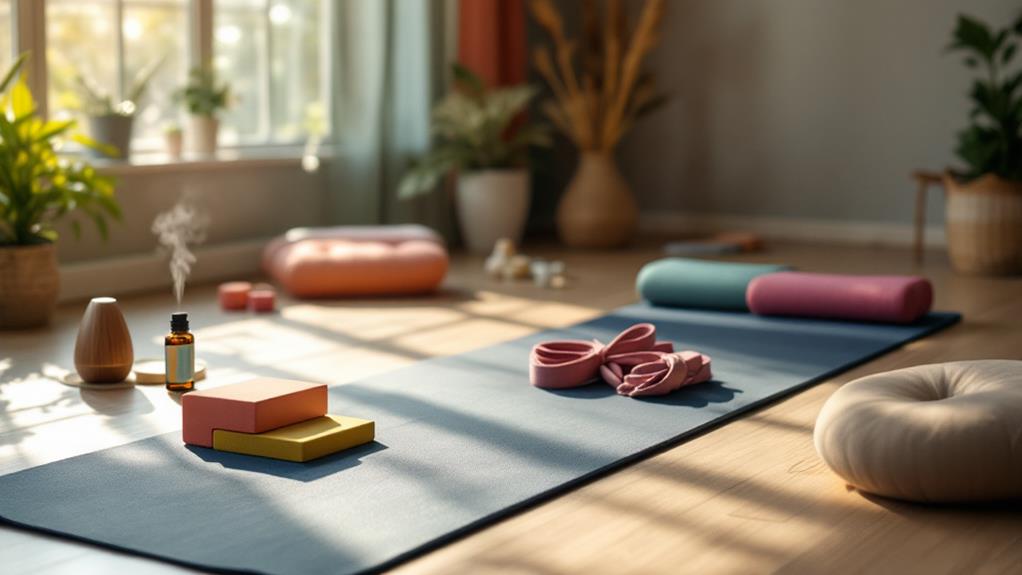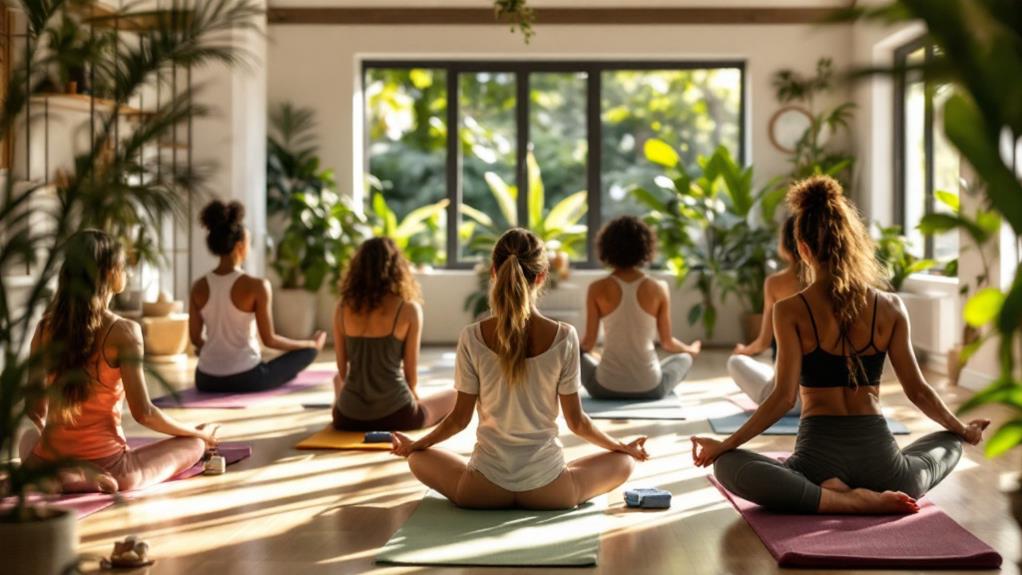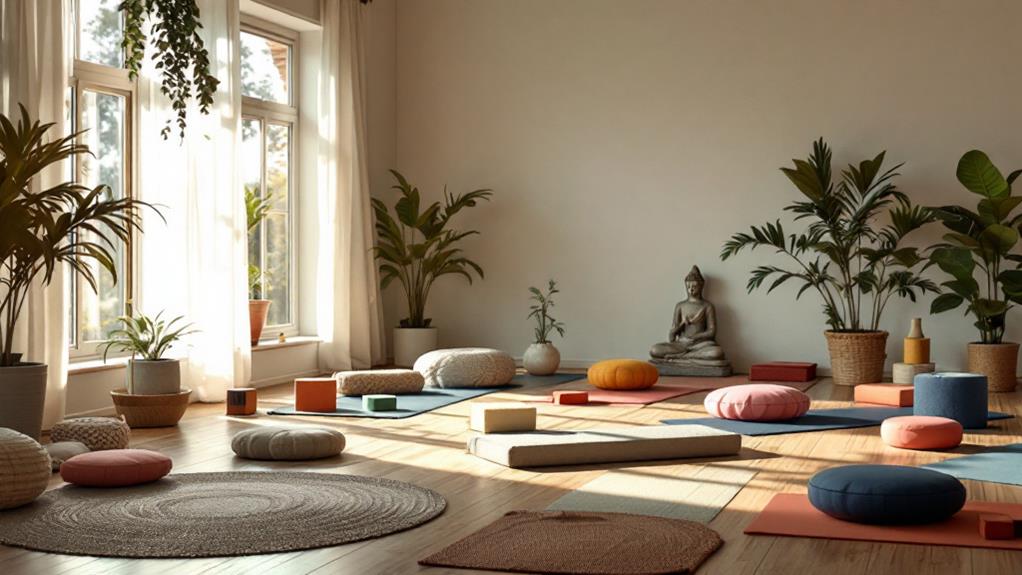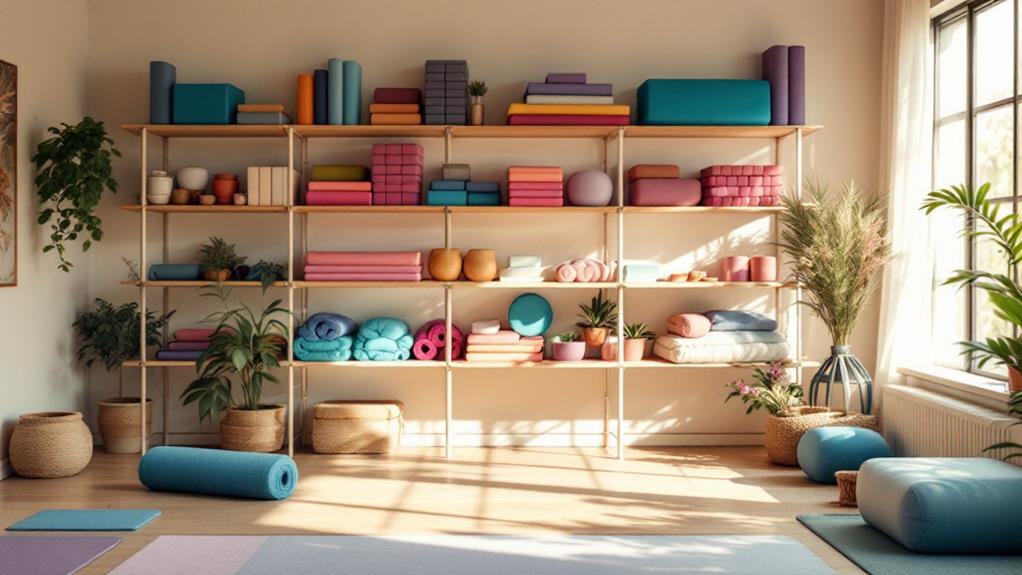A Beginner’s Guide to Yoga: Everything You Need to Know
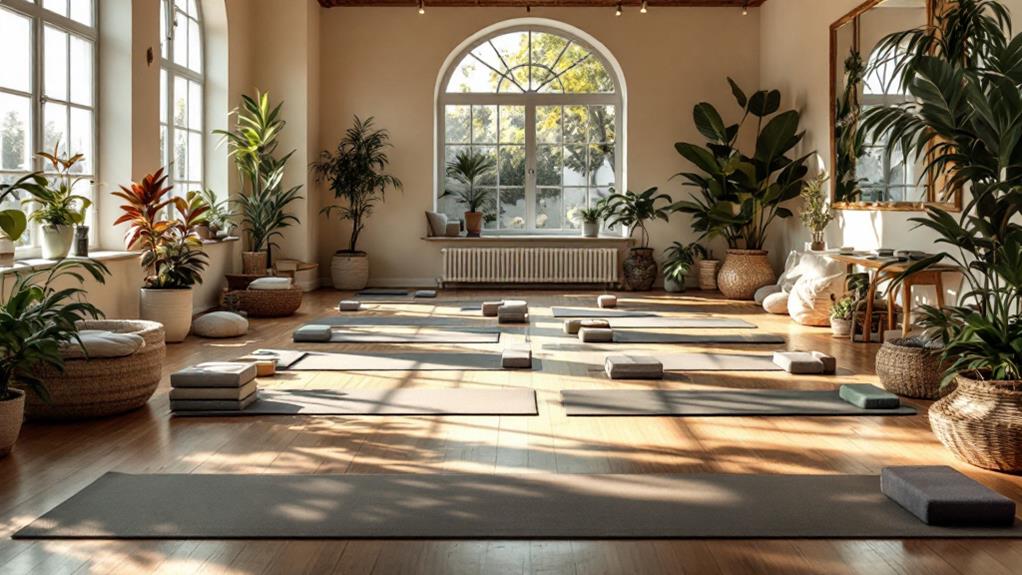
Initiating a yoga adventure? It integrates your mind, body, and spirit through practices like Hatha and Vinyasa, perfect for beginners. Yoga offers numerous health benefits, enhancing flexibility, strength, and mental well-being. Crucial gear includes a quality yoga mat, supportive blocks, and breathable clothing for effective practice. Start with beginner poses like Mountain and Child's Pose to build awareness and stability. Attend beginner-friendly classes or investigate online resources like Yoga with Adriene. Remember, practice in a calm, dedicated space and communicate with instructors about personal needs. As you continue, you'll reveal deeper insights and techniques.
Understanding Yoga Basics
Delving into the basics of yoga, you'll find that it's more than just a series of physical exercises; it's an all-encompassing practice that weaves together aspects of mind, body, and spirit. As a beginner to yoga, you'll uncover a wide variety of types of yoga classes that cater to different needs and preferences. Regardless of whether it's the dynamic flow of Vinyasa or the calming stillness of Yin, each style offers unique benefits. These different styles of yoga can help improve your flexibility, strength, and body awareness.
Yoga poses such as Mountain Pose, Child's Pose, and Downward Facing Dog lay a solid foundation for your practice. They're designed to cultivate body awareness, helping you connect deeply with your physical self. Breathing exercises, known as Pranayama, are integral to the physical practice, teaching you to control your breath and refine your focus.
Understanding the yoga philosophy is also essential. It's structured around the Eight Limbs of Yoga, which includes ethical guidelines and meditative practices, creating a holistic approach to personal growth. As you investigate this ancient practice, you'll find that yoga is a pathway of continuous learning and self-revelation.
Key Health Benefits
When you start practicing yoga, you'll quickly notice a range of health benefits that extend beyond flexibility and strength. Yoga regularly engages your body and mind, offering more than just a physical activity. By incorporating breathing techniques and mindfulness, yoga helps improve flexibility and reduces anxiety, leading to significant emotional well-being. Stress relief becomes more accessible as you lower cortisol levels, which can also boost your heart health.
Yoga isn't just about touching your toes; it also improves your posture and respiratory function. Through breath control techniques like pranayama, you'll enhance your cognitive abilities and emotional stability, especially during stressful times. Regular practice is also linked to better sleep quality—helping you wake up refreshed and ready to face the day. Let's not forget the social aspect; yoga often fosters a sense of community, which can lead to healthier eating habits and improved social connections.
Here are some key health benefits of practicing yoga:
- Improves flexibility and strength
- Reduces anxiety and promotes emotional well-being
- Boosts respiratory function and cognitive abilities
- Leads to better sleep quality and healthier habits
- Improves posture and general physical health
Popular Yoga Styles
While enjoying the health benefits yoga offers, you'll find it crucial to choose a style that suits your personal goals and preferences. In this beginner's guide to yoga styles, let's investigate some popular options. Hatha Yoga is a great starting point, focusing on individual poses and deep breathing techniques. This style helps beginners build a solid foundation in yoga practice by emphasizing mindfulness and physical awareness.
If you're looking for something more dynamic, consider Vinyasa Yoga. This style links breath with movement, creating a flowing sequence that improves cardiovascular fitness and flexibility. It's perfect for those who enjoy a more energetic practice while still fostering mindfulness.
For a slower pace, Yin Yoga might be your choice. It involves holding poses for longer periods, promoting deep relaxation and stretching connective tissues. This practice enhances joint mobility and is ideal for those seeking a tranquil experience.
Restorative Yoga is all about relaxation and gentle stretching. This style uses props to support the body, making it perfect for stress relief and recovery after intense workouts.
Lastly, Ashtanga Yoga caters to those wanting a physically demanding routine. It follows a structured sequence, building strength and endurance. Choose a style that aligns with your goals and enjoy the experience!
Beginner-Friendly Poses
Starting your yoga expedition with a few beginner-friendly poses can make the practice more approachable and enjoyable. These poses help establish a strong foundation, ensuring you achieve proper alignment and confidence on your yoga mat. Begin with the Mountain Pose, a foundational posture that increases body awareness by engaging leg muscles and the core, while improving your posture and balance. As you progress, the Child's Pose offers a restorative break, stretching the lower back and hips, providing a calm moment to rest.
The Downward Facing Dog is a key pose that strengthens your entire body and improves flexibility. It also provides a gentle inversion to help relieve stress. For an increase in spinal flexibility and back strength, the Cobra Pose is crucial. It opens the chest and improves respiratory function, making it a significant component of your routine.
Try incorporating the Cat-Cow Stretch, a dynamic flow that increases spinal mobility and relieves tension, into your practice. It also improves breath coordination. Yoga teachers often recommend these poses to newcomers due to their accessibility and benefits.
Here's a quick checklist of beginner-friendly poses:
- Mountain Pose
- Child's Pose
- Downward Facing Dog
- Cobra Pose
- Cat-Cow Stretch
Essential Yoga Gear
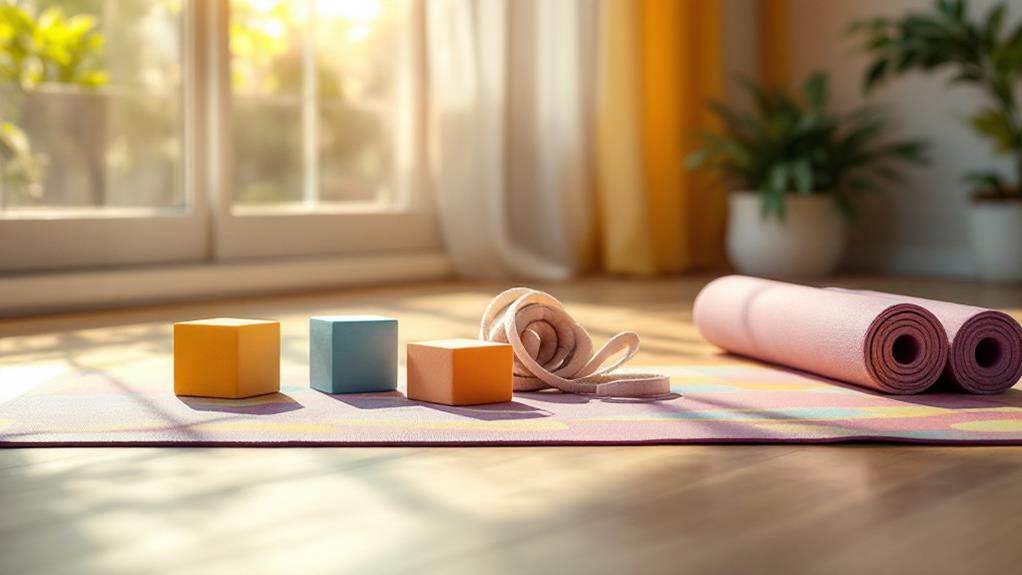
Equipping yourself with the right yoga gear improves your practice and guarantees safety and comfort. A high-quality yoga mat is a must-have, providing vital grip and cushioning to prevent slips and injuries. Look for mats at least 1/4 inch thick to secure both comfort and stability during your sessions. Yoga blocks are invaluable, especially for beginners, as they offer support and stability, helping you achieve proper alignment without straining. They allow you to deepen poses and maintain alignment effortlessly.
Yoga straps are another important tool, particularly useful for those developing their flexibility. They help extend your reach and maintain proper form, making certain you can practice yoga with confidence. Don't forget to dress in a comfortable outfit; yoga pants made from breathable, stretchy fabric allow for ease of movement and help regulate your body temperature.
Keeping a water bottle nearby is vital for maintaining hydration before, during, and after your sessions. Staying hydrated supports peak performance and recovery, enhancing your breathing and focus. By investing in the right gear, you create a more enjoyable and effective yoga practice, allowing you to focus on your growth and well-being.
Breathwork Techniques
After you've equipped yourself with the right yoga gear, it's time to focus on another vital aspect of your practice: breathwork techniques. These techniques are fundamental for improving your yoga experience, offering numerous benefits like enhanced respiratory function and cardiovascular health. One popular method is Ujjayi Breath, which involves a slight constriction of the throat to create an audible breath, promoting focus and relaxation. Adding this to your regular yoga practice can also aid in stress management and anxiety reduction.
Another effective technique is Alternate Nostril Breathing, or Nadi Shodhana, which balances the brain's hemispheres and increases mental clarity. By equalizing breath flow, it greatly reduces anxiety. Sitali Pranayama, known as the cooling breath, involves inhaling through a rolled tongue and exhaling through the nose, helping to lower body temperature and calm the mind.
Incorporating these breathwork techniques into your daily routine can lead to emotional stability and a comprehensive sense of well-being. Here are some breathwork benefits to keep in mind:
- Improves focus and relaxation
- Enhances cardiovascular health
- Promotes mental clarity
- Aids stress management and anxiety reduction
- Increases emotional stability and well-being
Embrace these practices to enrich your yoga experience.
Finding the Right Class
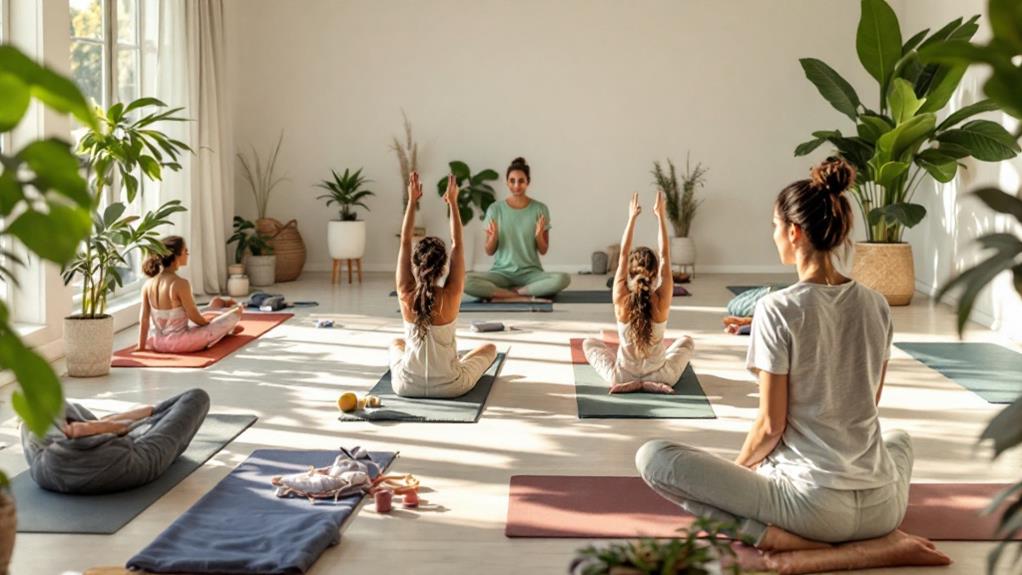
Choosing the right yoga class is crucial to enhancing your practice and meeting your personal goals. Start by considering what you want to achieve, regardless of it being relaxation, strength, or flexibility. Knowing your goals helps in finding the right class that aligns with your needs. Research local yoga studios by reading reviews to find beginner-friendly classes led by experienced instructors. Such instructors should offer a welcoming environment that makes you feel comfortable and supported.
Trial classes or new student passes are great ways to investigate different teaching styles and atmospheres. They help you decide without committing to a full membership right away. Look for classes emphasizing foundational poses and alignment. These classes build your confidence and guarantee safety, especially if you're new to yoga.
Communication with instructors is key. Before class, talk to them about your experience level and any physical limitations. This allows them to provide necessary modifications and support tailored to your needs, ensuring a more personalized experience. A good instructor will adapt the class to suit everyone, making your expedition enjoyable and effective. Remember, the right class sets the foundation for a successful and fulfilling yoga practice.
Beginner Practice Tips
A yoga mat becomes your personal sanctuary as you initiate your beginner's adventure. Starting with 20-30 minute sessions, aim for consistent practice 2-3 times a week. This approach helps build a strong foundation, allowing you to gradually increase your duration as you grow more comfortable with the practice. When you practice at home, choose a quiet and comfortable space free from distractions. This improves your focus and mindfulness, essential elements for yoga students starting on this path.
Utilize props such as yoga blocks and straps to support proper alignment and make poses more accessible. These tools are invaluable, especially for beginner yoga practitioners. To find the right class, research different types of yoga to align with your personal preferences and goals. Attending beginner-friendly classes provides a supportive environment where you can thrive.
Communication is key, so talk to your instructors about your experience level and any physical concerns. This guarantees they can provide appropriate modifications and guidance during your practice.
Here are some tips to get started:
- Start with short, consistent practice sessions
- Create a distraction-free environment
- Use props to improve alignment
- investigate different types of yoga
- Communicate openly with instructors
Class Etiquette Essentials
Upon entering a yoga class, adhering to class etiquette is vital for creating a harmonious environment. Arriving early gives you time to settle in and improve your focus, showing respect for your teacher and fellow practitioners. This simple courtesy guarantees you're ready when the class begins, minimizing any potential distractions.
Before stepping into yoga studios, make certain to silence your mobile devices. This small action helps maintain a serene atmosphere, allowing everyone to engage themselves fully in their practice. Once the class starts, avoid talking. This silence is fundamental in preserving the calm energy needed for concentration and mindfulness throughout the session.
Each yoga studio might have its own unique studio guidelines, so be certain to follow them closely. Regardless of whether it's about mat placement, using props, or observing personal space, these rules are designed to foster an inclusive and respectful setting for all. Enter and exit the yoga space quietly, respecting the sacredness of the environment. This quietness allows the flow of energy to remain uninterrupted, benefiting everyone in the class. By observing these etiquette fundamentals, you contribute positively to the collective experience, improving your path and that of others.
Recommended Online Resources
In the current online age, investigating yoga from the comfort of your home is easier than ever, thanks to a wealth of online resources. If you're beginning your yoga path, numerous websites and apps offer free yoga classes specifically tailored for beginners. Platforms like Yoga with Adriene and Down Dog make it simple to start your practice at home. YouTube channels are another excellent resource, with "Yoga with Adriene" providing a range of themed videos from quick 10-minute flows to full-length sessions.
For those seeking more diversity, online platforms such as Glo and Gaia offer subscription-based services, granting access to extensive libraries of yoga classes, tutorials, and workshops. These platforms allow you to investigate different styles and connect with multiple teachers who provide valuable practice tips. Social media platforms, especially Instagram, offer daily inspiration, showcasing new instructors and short practice demonstrations.
Many online yoga communities and forums are also available, providing spaces where beginners can ask questions, share experiences, and receive support as they navigate their path. To get started, investigate these resources:
- Yoga with Adriene
- Down Dog
- Glo
- Gaia
- Instagram yoga communities

